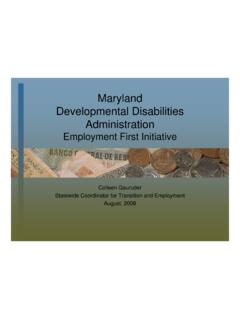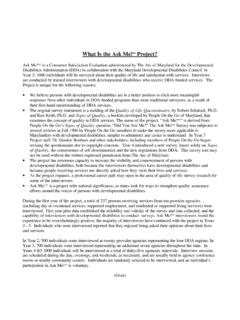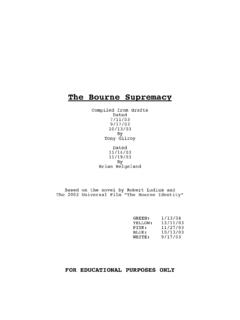Transcription of Michael Smull & Mary Lou Bourne - Reinventing Quality
1 Michael Smull & Mary Lou BourneThe Learning Community For Person Centered PracticesAugust 10 The Learning Community for Person Centered Practices 1 People were known by their reputation their challenging behaviors People need a setting where what is important to them and how to best support them is present Clinical issues still need to be addressed but in the context of supportive/healing settings Risk management needs to be seen and addressed in this contextAugust 10 The Learning Community for Person Centered Practices 2 The concepts were valid but embedded in a planning process and planning often became rote and disconnected from implementation We have to teach and use person centered thinking skills more than person centered planning skills Clinicians saw and see their approach and this approach as either or not bothAugust 10 The Learning Community for Person Centered Practices 3 We begin by holding people with ID to a higher standard of behavior When they do not conform we impose restrictions against which they push We escalate they escalate We then attach labels to the person biter , eloper, non compliant.
2 Which make it easier to justify interventions designed to make them reach criteria August 10 The Learning Community for Person Centered Practices 4We learn what we measure and don t measure what we need to learnAugust 10 The Learning Community 5 August 10 The Learning Community for Person Centered Practices 67 Helen Sanderson Associates/TLCPCPC reated by The Grove Consultants InternationalWhat is important to a person includes those things in life which help us to be satisfied, content, comforted and happy. It includes: People to be with /relationships Things to do Places to go Rituals or routines Rhythm or pace of life Things to have Important TO: ant toAugust 10 The Learning Community for Person Centered Practices 8 Includes what matters the most to the person their own definition of Quality of life.
3 What is important to a person includes only what people say : with their words with their behavior When words and behavior are in conflict, listen to the ToAugust 10 The Learning Community for Person Centered Practices 9 What is important for people, includes only those things that we need to keep in mind regarding Issues of health or safety Physical health and safety, including wellness and prevention Emotional health and safety, including support needed What others see as important to help the person be a valued member of their communityImportant forAugust 10 The Learning Community for Person Centered Practices 10 Balancing Important TO and FOR The Learning Community for Person Centered Practices, Inc.
4 2008 Sequence matters: learning about what matters the most to the person first, is a critical aspect It is not about either/or; paying attention to health, safety and valued social roles is critical, but alone it is insufficient if not in the context of important TO. Risk management techniques currently often focus on assuring safety or health at the cost of what creates satisfaction for the person; need to change our frame of reference to believe that both can co-existAugust 10 The Learning Community for Person Centered Practices 11 No one willingly addresses what is important for unless a piece of it is important to Without an important to hook our only option is coercionAugust 10 The Learning Community for Person Centered Practices 12 ToxicToleratedSupportiveHealingLooking at the environmentAugust 10 The Learning Community for Person Centered Practices 13 Compare what is important to with what is present.
5 Who the person spends time with, is around. The nature of the setting loud/quiet, etc The tolerance of the setting The presence or absence of the key parts of what is important to statusAugust 10 The Learning Community for Person Centered Practices 14 Does the person like the key people involved in support? Do the key people involved in support like the person? Is there a good match between the person, those providing support, and those living with or working beside the person? Do the people who are supporting the person know what is important to the person? What explanation do those who provide support give when asked why the person is behaving in ways that are challenging?August 10 The Learning Community for Person Centered Practices 15 What are the explanations for the issues/behaviors?
6 What is best practice in treatment for people with the diagnosis that has been given? Is it present? Are their alternative ways to understand the behavior that have not been tried and would give a positive way forward? If part of the understanding is psychological trauma what would a healing environment look like for the person?August 10 The Learning Community for Person Centered Practices 16 August 10 The Learning Community for Person Centered Practices 17 SatisfiedHappyDisappointedAngryPresenceI mportanceAugust 10 The Learning Community for Person Centered Practices 18 What is happening does We think it means And we shouldListening to communication chartAugust 10 The Learning Community 19 What Is HappeningWhat The Person DoesWhat It May MeanWhat We Should DoCarl has friends stayingat his apartmentQuit bathing, shaving, brushing teeth, wearing clean clothing, missing work.
7 Missing appointments with support staff, missing medicationsCarl is being distracted usually by friends who try to tell him how his life should be like: you don t need meds, you can get a better jobstart reminding him about why he wantsto take his medicine (can be1:1, small group, or big meeting); ask if he needs help with his friendsCarlis living his lifecall/page people says everything is going wrong and wants to talk to ya More than likely he had a fight or has a problemAsk questions to find out what everything really means and offer adviceWhen he wakes upHe s grouchy (snap at you or tell you to lay off or won t talk)He s really tired or hasn t taken his medsLet him be or if he needs to talk just talk to him, check tosee if he has taken his medication and remind him if he hasn tIn conversation discussing something about his lifeHe says True He agrees with you and will work on the issueHave him confirm what he is going to do and then follow up to see if he did what he saidhe would.
8 Tell him you re proud of himAugust 10 The Learning Community for Person Centered Practices 20 For the Person - Use of the communication chart in day to day support insures that - There is an increase in the presence of what is important to the person People using services feel listened to There is a decrease in frustration and the behaviors that go with it For the Organization - Recognizes learning done by those who support Reinforces learning culture Provides new/relief staff with a quick way to get off to a good start Decrease in challenging behaviors and therefore a decrease in incidents Increases/reinforces observational skills August 10 TLC 21 August 10 The Learning Community 22 Supports wanted and neededSkills neededPersonality Characteristics NeededShared common interests (would be nice to have)For each Person what are.
9 For the Person - Because staff find more pleasure in their work they stay longer (more stability) Where there is a good match People who use services are more likely to have what is important to them New learning about what is important to people is more likely to happen For the Organization - Reduces turnover Makes those who use and provide services feel valued/respected Helps support real relationships Decreases likelihood of incidentsAugust 10 The Learning Community 23 August 1024 Helen Sanderson Associates/TLCPCPC reated by The Grove Consultants InternationalFor the Person - Results in greater clarity about what needs to stay the same and what needs to change in each person s life Helps in determining goals/outcomes that help the person move toward a desired life For the Organization - Teaches critical thinking
10 Promotes better problem solving Leads to clarity about what needs to change and what needs to stay the same Supports a learning culture August 10 The Learning Community 25 August 10 The Learning Community for Person Centered Practices 26 For the Person - Because people are recording what is working and not working in support More of what is working and Less of what is not working will occur For the Organization - Those doing the work feel listened to Learning done by those doing the work is recorded Helps with problem solving/hypothesis testing Creates good paper Reinforces a learning culture and teaches critical thinking August 10 The Learning Community 27 Using the 4 questions to focus on learning and acting on that learning What have we tried?








